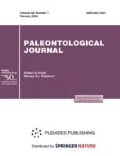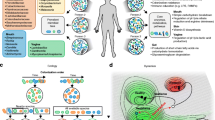Abstract
The GC content and genome size are integral genomic characteristics limiting potential range of licenses (environments) of prokaryotic taxa. In silico, associations of these characteristics and taxa deviating from the general trend are revealed. Relationships with ecology and early prokaryotic evolution are discussed.
Similar content being viewed by others
References
Basak, S. and Ghosh, T.C., On the Origin of Genomic Adaptation at High Temperature for Prokaryotic Organisms, BBRC, 2005, vol. 330, no. 3, pp. 629–632.
Basu, B. and Apte, S.K., Gamma Radiation-Induced Proteome of D. radiodurans Primarily Targets DNA Repair and Oxidative Stress Alleviation, Mol. Cell Proteomics., 2012, vol. 11, no. 1, M111.011734.
Beblo, K., Douki, T., Schmalz, G., et al., Survival of Thermophilic and Hyperthermophilic Microorganisms after Exposure to UV-C, Ionizing Radiation and Desiccation, Arch. Microbiol., 2011, vol. 193, no. 11, pp. 797–809.
Bohlin, J. and Skjerve, E., Examination of Genome Homogeneity in Prokaryotes Using Genomic Signatures, PLoS One, 2009, vol. 4, no. 12, p. e8113.
Bohlin, J., Snipen, L., Hardy, S.P., et al., Analysis of Intra-Genomic GC Content Homogeneity within Prokaryotes, BMC Genom., 2010, vol. 11, p. 464.
Chankova, S.G. and Yurina, N.P., Micro-algae As Model System for Studying of Genotype and Induced Resistance to Oxidative Stress, in Modern Problems of Genetics, Radiobiology, Radioecology and Evolution, Dubna, 2010, p. 11.
Cordero, O.X. and Hogeweg, P., The Consequences of Base Pair Composition Biases for Regulatory Network Organization in Prokaryotes, Mol. Biol. Evol., 2009, vol. 26, no. 10, pp. 2171–2173.
Daly, M.J., Gaidamakova, E.K., Matrosova, V.Y., et al., Accumulation of Mn(II) in D. radiodurans Facilitates Gamma-Radiation Resistance, Science, 2004, vol. 306, no. 5698, pp. 1025–1028.
Daniel, I., Oger, P., and Winter, R., Origins of Life and Biochemistry under High-Pressure Conditions, Chem. Soc. Rev., 2006, vol. 35, no. 10, pp. 858–875.
Foerstner, K.U., von Mering, C., Hooper, S.D., and Bork, P., Environments Shape the Nucleotide Composition of Genomes, EMBO Rep., 2005, vol. 6, no. 12, pp. 1208–1213.
Forterre, P., Displacement of Cellular Proteins by Functional Analogues from Plasmids or Viruses Could Explain Puzzling Phylogenies of Many DNA Informational Proteins, Mol. Microbiol., 1999, vol. 33, no. 3, pp. 457–465.
Fraser, C.M., Gocayne, J.D., White, O., et al., The Minimal Gene Complement of Mycoplasma genitalium, Science, 1995, vol. 270, no. 5235, pp. 397–403.
Garrett, R.A. and Klenk, H.-P., Eds., Archaea: Evolution, Physiology, and Molecular Biology, Blackwell Publ. Ltd., 2007.
Glass, J.I., Assad-Garcia, N., Alperovich, N., et al., Essential Genes of a Minimal Bacterium, Proc. Natl. Acad. Sci. USA, 2006, vol. 103, no. 2, pp. 425–430.
Gunbin, K.V., Suslov, V.V., and Afonnikov, D.A., Phylogenetic Analysis of Housekeeping Archaeal Proteins and the Early Stages of Archaeal Evolution, Paleontol. J., 2013, vol. 47, no. 9, pp. 000–000.
Hurst, L.D. and Merchant, A.R., High Guanine-Cytosine Content Is not an Adaptation to High Temperature: A Comparative Analysis amongst Prokaryotes, Proc. Biol. Sci., 2001, vol. 268, no. 1466, pp. 493–497.
Joshi, B., Schmid, R., Altendorf, K., et al., Protein Recycling Is a Major Component of Post-Irradiation Recovery in Deinococcus radiodurans Strain R1, BBRC, 2004, vol. 320, no. 4, pp. 1112–1117.
Kurtz, D.M., Microbial Detoxification of Superoxide: The Non-heme Iron Reductive Paradigm for Combating Oxidative Stress, Acc. Chem. Res., 2004, vol. 37, no. 11, pp. 902–908.
Levchenko, V.F., Modeli v teorii biologicheskoi evolyutsii (Models in the Theory of Biological Evolution), St. Petersburg: Nauka, 1993.
Lombardot, T., Bauer, M., Teeling, H., et al., The Transcriptional Regulator Pool of the Marine Bacterium Rhodopirellula baltica SH 1T As Revealed by Whole Genome Comparisons, FEMS Microbiol. Let., 2005, vol. 242, no. 1, pp. 137–145.
McInerney, J.O., Martin, W.F., Koonin, E.V., et al., Planctomycetes and Eukaryotes: A Case of Analogy not Homology, BioEssays, 2011, vol. 33, no. 11. pp. 810–817.
Mushegian, A.R. and Koonin, E.V., A Minimal Gene Set for Cellular Life Derived by Comparison of Complete Bacterial Genomes, Proc. Natl. Acad. Sci. USA, 1996, vol. 93, no. 19, pp. 10268–10273.
Namsaraev, B.B., Abidueva, E.Yu., and Lavrent’eva, O.P., et al., Ekologiya mikroorganizmov ekstremal’nykh vodnykh sistem (Ecology of Microorganisms of Extreme Aquatic Systems), Ulan-Ude: Buryat. Gos. Univ., 2008.
Naya, H., Romero, H., Zavala, A., et al., Aerobiosis Increases the Genomic Guanine Plus Cytosine Content (GC%) in Prokaryotes, J. Mol. Evol., 2002, vol. 55, no. 3, pp. 260–264.
Nivière, V. and Fontecave, M., Discovery of Superoxide Reductase: An Historical Perspective, J. Biol. Inorg. Chem., 2004, vol. 9, no. 2, pp. 119–123.
Oliver, J.L. and Marín, A.J., A Relationship between GC Content and Coding-Sequence Length, Mol. Evol., 1996, vol. 43, no. 3, pp. 216–223.
Omelchenko, M.V., Wolf, Y.I., Gaidamakova, E.K., et al., Comparative Genomics of Thermus thermophilus and Deinococcus radiodurans: Divergent Routes of Adaptation to Thermophily and Radiation Resistance, BMC Evol. Biol., 2005, vol. 5, p. 57.
Orlov, Y.L. and Potapov, V.N., Complexity: An Internet Resource for Analysis of DNA Sequence Complexity, NAR, 2004, vol. 32, web server issue, pp. W628–W633.
Rozanov, A.Yu., Life Conditions on the Early Earth after 4.0 Ga, in Problemy proiskhozhdeniya zhizni (Problems of the Origin of Life), Rozanov, A.Yu., Lopatin, A.V., and Snytnikov, V.N., Eds., Moscow: Paleontol. Inst. Ross. Akad. Nauk, 2009, pp. 185–201.
Rye, R. and Holland, H.D., Paleosoils and the Evolution of Atmospheric Oxygen; Acritical Review, Am. J. Sci., 1998, vol. 298, no. 8, pp. 621–672.
Schmid, A.K., Howell, H.A., and Battista, J., R, et al., Global Transcriptional and Proteomic Analysis of the Sig1 Heat Shock Regulon of D. radiodurans, J. Bacteriol., 2005, vol. 187, no. 10, pp. 339–351.
Sghaier, H., Ghedira, K., Benkahla, A., and Barkallah, I., Basal DNA Repair Machinery Is Subject to Positive Selection in Ionizing-Radiation-Resistant Bacteria, BMC Genom., 2008, vol. 9, p. 297.
Singer, C.E. and Ames, B.N., Sunlight Ultraviolet and Bacterial DNA Base Ratios, Science, 1970, vol. 170, no. 3960, pp. 822–825.
Slade, D. and Radman, M., Oxidative Stress Resistance in Deinococcus radiodurans, Microbiol. Mol. Biol. Rev., 2011, vol. 75, no. 1, pp. 133–191.
Suslov, V.V., Par Force Evolution As a Mechanism for Rapid Adaptation, Paleontol. Zh., 2013, vol. 47, no. 9, pp. 1048–1055.
Suslov, V.V., Optimization of Stress in the Evolution of Brain, in VI vstrecha laureatov Nobelevskoi premii v SanktPeterburge “Fiziologiya i meditsina XXI veka.” Tezisy sektsionnykh i posternykh dokladov (VI Meeting of the Nobel Prize Laureates in St. Petersburg on Physiology and Medicine in the 21st Century: Theses of Section and Poster Reports), St. Petersburg: Izd. Politekhn. Univ., 2011, pp. 115–117.
Trifonov, E.N., Genetic Content of DNA Sequences Is Determined by Superposition of Many Codes, Mol. Biol., 1997, vol. 31, no. 4, pp. 759–767.
Wang, H.C., Susko, E., and Roger, A.J., On the Correlation between Genomic G+C Content and Optimal Growth Temperature in Prokaryotes: Data Quality and Confounding Factors, BBRC, 2006, vol. 342, no. 3, pp. 681–684.
Woese, C.R. and Fox, G.E., The Concept of Cellular Evolution, J. Mol. Evol., 1977, vol. 10, no. 1, pp. 1–6.
Wu, H., Zhang, Z., Hu, S., and Yu, J., On the Molecular Mechanism of GC Content Variation among Eubacterial Genomes, Biol. Direct., 2012, vol. 7, p. 2.
Zavarzin, G.A., The First Ecosystems on the Earth, in Problemy proiskhozhdeniya zhizni (Problems of the Origin of Life), Rozanov, A.Yu., Lopatin, A.V., and Snytnikov, V.N., Eds., Moscow: Paleontol. Inst. Ross. Akad. Nauk, 2009, pp. 230–244.
Zhao, X., Zhang, Z., Yan, J., and Yu, J., GC Content Variability of Eubacteria Is Governed by the Pol III Alpha Subunit, BBRC, 2007, vol. 356, no. 1, pp. 20–25.
Author information
Authors and Affiliations
Corresponding author
Rights and permissions
About this article
Cite this article
Suslov, V.V., Afonnikov, D.A., Podkolodny, N.L. et al. Genome features and GC content in prokaryotic genomes in connection with environmental evolution. Paleontol. J. 47, 1056–1060 (2013). https://doi.org/10.1134/S0031030113090220
Received:
Published:
Issue Date:
DOI: https://doi.org/10.1134/S0031030113090220




